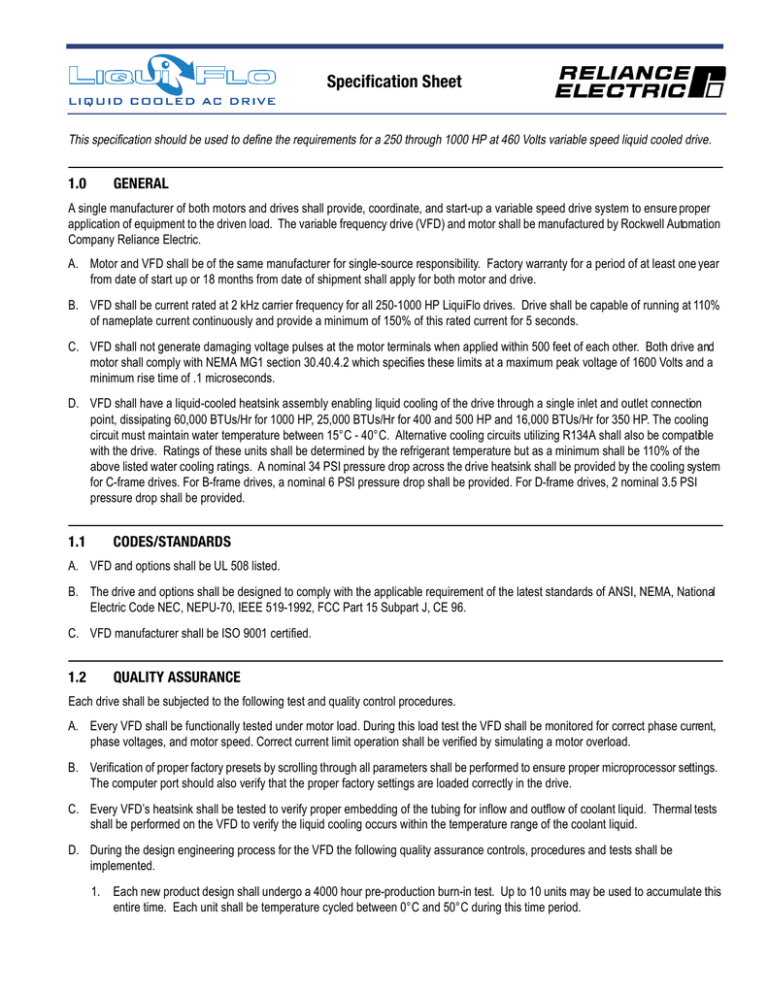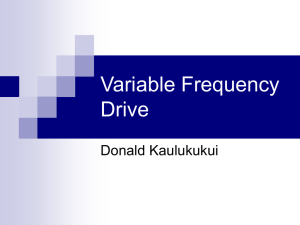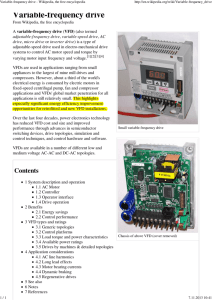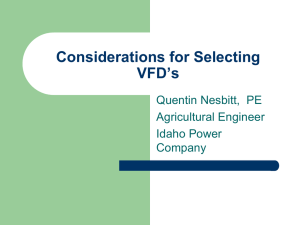
Specification Sheet
This specification should be used to define the requirements for a 250 through 1000 HP at 460 Volts variable speed liquid cooled drive.
1.0
GENERAL
A single manufacturer of both motors and drives shall provide, coordinate, and start-up a variable speed drive system to ensure proper
application of equipment to the driven load. The variable frequency drive (VFD) and motor shall be manufactured by Rockwell Automation
Company Reliance Electric.
A. Motor and VFD shall be of the same manufacturer for single-source responsibility. Factory warranty for a period of at least one year
from date of start up or 18 months from date of shipment shall apply for both motor and drive.
B. VFD shall be current rated at 2 kHz carrier frequency for all 250-1000 HP LiquiFlo drives. Drive shall be capable of running at 110%
of nameplate current continuously and provide a minimum of 150% of this rated current for 5 seconds.
C. VFD shall not generate damaging voltage pulses at the motor terminals when applied within 500 feet of each other. Both drive and
motor shall comply with NEMA MG1 section 30.40.4.2 which specifies these limits at a maximum peak voltage of 1600 Volts and a
minimum rise time of .1 microseconds.
D. VFD shall have a liquid-cooled heatsink assembly enabling liquid cooling of the drive through a single inlet and outlet connection
point, dissipating 60,000 BTUs/Hr for 1000 HP, 25,000 BTUs/Hr for 400 and 500 HP and 16,000 BTUs/Hr for 350 HP. The cooling
circuit must maintain water temperature between 15°C - 40°C. Alternative cooling circuits utilizing R134A shall also be compatible
with the drive. Ratings of these units shall be determined by the refrigerant temperature but as a minimum shall be 110% of the
above listed water cooling ratings. A nominal 34 PSI pressure drop across the drive heatsink shall be provided by the cooling system
for C-frame drives. For B-frame drives, a nominal 6 PSI pressure drop shall be provided. For D-frame drives, 2 nominal 3.5 PSI
pressure drop shall be provided.
1.1
CODES/STANDARDS
A. VFD and options shall be UL 508 listed.
B. The drive and options shall be designed to comply with the applicable requirement of the latest standards of ANSI, NEMA, National
Electric Code NEC, NEPU-70, IEEE 519-1992, FCC Part 15 Subpart J, CE 96.
C. VFD manufacturer shall be ISO 9001 certified.
1.2
QUALITY ASSURANCE
Each drive shall be subjected to the following test and quality control procedures.
A. Every VFD shall be functionally tested under motor load. During this load test the VFD shall be monitored for correct phase current,
phase voltages, and motor speed. Correct current limit operation shall be verified by simulating a motor overload.
B. Verification of proper factory presets by scrolling through all parameters shall be performed to ensure proper microprocessor settings.
The computer port should also verify that the proper factory settings are loaded correctly in the drive.
C. Every VFD’s heatsink shall be tested to verify proper embedding of the tubing for inflow and outflow of coolant liquid. Thermal tests
shall be performed on the VFD to verify the liquid cooling occurs within the temperature range of the coolant liquid.
D. During the design engineering process for the VFD the following quality assurance controls, procedures and tests shall be
implemented.
1. Each new product design shall undergo a 4000 hour pre-production burn-in test. Up to 10 units may be used to accumulate this
entire time. Each unit shall be temperature cycled between 0°C and 50°C during this time period.
Specification Sheet
2. Digital integrated circuits shall undergo functional and reliability tests. Regulator circuits must use reliable and compact surface
mount construction. These circuits shall be 100% tested on computer-controlled systems. Test equipment must be
documented, controlled and calibrated to ISO 9001 standards.
3. Each drive power circuit shall be tested under motor load conditions. While loaded, the output waveform shall be monitored for
correct PWM algorithm. Short circuit testing shall be done to UL standards and an AIC rating placed on each controller
nameplate.
4. All components utilized with the basic VFD-like contactors, overload relays, pushbuttons, pilot devices, and other control devices
shall be UL recognized. These components shall be manufactured by Allen Bradley Company.
1.3
SERVICE
The VFD manufacturer shall maintain and staff world-wide service centers. The manufacturers shall have the ability to test both the drives
and motors in these service centers.
A. Start-up shall be included for each VFD provided.
B. Service engineers shall be employed by the manufacturer or be certified by the manufacturer and provide start-up service including
physical inspection of drive and connected wiring and final adjustments to meet specified performance requirements.
2.0
DRIVE FUNCTIONS
The VFD shall have the following basic features:
A. An electronic overload circuit designed to protect an AC motor operated by the VFD output from extended overload operation on an
inverse time basis. This electronic overload shall be UL and NEC recognized as adequate motor protection. No additional hardware
such as motor overload relays or motor thermostats shall be required.
B. An LED display that digitally indicates:
1. Frequency output
2. Voltage output
3. Current output
4. Motor RPM
5. Input kW
6. Elapsed time
7. Time stamped fault indication
8. DC bus volts
C. The VFD shall have the capability of riding though power dips up to 10 seconds without a controller trip depending on load and
operating condition. In this extended ride through, the drive shall use the energy generated by the load inertia of the motor fan as a
power source for all electronic circuits.
D. RS232 Port and Windows™ based software for Configuration, Control, and Monitoring.
E. An isolated 0-20 mA, 4-20 mA or 0-4, 0-8, 0-10 V analog speed input follower.
F.
An isolated 0-10 V or 4-20 mA output signal proportional to speed or load.
Specification Sheet
G. The VFD shall have the capability of riding though power dips up to 10 seconds without a controller trip depending on load and
operating condition. In this extended ride through, the drive shall use the energy generated by the rotating motor as a power source
for all electronic circuits.
H. Standard I/O expansion interface card with the following features:
1. PI regulator for set point control
2. Four isolated 24 VDC programmable digital inputs
3. An additional analog input for speed feedback to PI regulator
4. One frequency input (0 to 200 Hz) for digital control of speed or trim reference
5. Four programmable isolated digital outputs (24 VDC rated)
6. One Form A output relay rated at 250 VAC or 24 VDC
7. Two NO/NC programmable output relays rated at 250 VAC or 24 VDC
2.1
PROTECTIVE CIRCUITS AND FEATURES
The VFD shall include the following protective circuits and features:
1. Motor current exceeds 200% of drive continuous current rating.
2. Output phase-to-phase short circuit condition.
3. Total ground fault under any operating condition.
4. High input line voltage.
5. Low input line voltage.
6. Loss of input or output phase.
7. External fault. (This protective circuit shall permit wiring of remote N.C. safety contact to shut down the drive).
8. Metal oxide varistors for surge suppression shall be provided at the VFD input terminals.
2.2
SERVICE CONDITION
The VFD shall be designed and constructed to operate within the following service conditions:
A. Suitable for continuous operation at an ambient temperature of 0oC to 40oC, elevation up to 3300 feet altitude with a relative humidity
to 95% non-condensing.
B. AC line variation of -10% to + 10% Voltage and +5 Hz Frequency.
C. AC line distribution system capacity shall not exceed 85,000 Amps symmetrical available fault current.
2.3
GENERAL OPTIONS AND MODIFICATIONS
The following options shall be included as specified in the document:
A. The panel mount kit shall have the following options:
• A fan for cabinet cooling and associated mounting brackets.
• Three bus bar to cable adapters for connection to user supplied six pulse rectifier input.
Specification Sheet
• Three bus bar to cable adapters for connection to user supplied motor leads.
• Two 10” hoses for extension from the inlet and the outlets of the liquid-cooled heatsink assembly.
• One sheet metal panel to cover the control boards.
B. Input line fuses shall provide protection for the input rectification circuit using Class J fuses with interrupting rating of 200,000 AIC.
The series interrupting rating of the VFD and fuses shall be a minimum of 85,000 AIC and shall be stated in the VFD instruction
manual as required by UL. Another option for protection of the input circuit shall be through circuit breakers.
C. A main input disconnect shall mount within the standard NEMA 1 or NEMA 4 enclosure for positive power disconnect of the VFD. It
shall have the capability for door padlocking.
D. A 3-phase 3% impedance input line reactor shall be provided to minimize drive harmonics on the AC line and protect the drive from
damaging electrical system transients. The 414-643 Amp VFD shall also include the capability for 12-pulse connection using an
isolation transformer with a phase shifting secondary.
E. Communication option card shall allow direct connection from the LiquiFlo to the host controller bus architecture. All configuration
and control functions can be accessed through this card, allowing direct communication between the LiquiFlo microprocessor and the
host system. Fault diagnostics, start/stop, speed commands, and all drive feedbacks shall be available over a single network
communication connection.
Networking options shall be available with the above listed functionality to directly connect to:
• Siemens Building Technologies P1-FLN Apogee® Protocol
• Johnson Metasys N2
• DeviceNet
• ControlNet
• Automax
• Modbus
• BACnet
• Profibus
• Interbus-S
Publication D-512 - July 2000
U.S. Drives Technical Support
Tel: (1) 262.512.8176, Fax: (1) 262.512.2222, Email: support@drives.ra.rockwell.com, Online: www.ab.com/support/abdrives
Trademarks not belonging to Rockwell Automation are property of their respective companies.
Publication D-512- July 2000
Copyright © 2000 Rockwell Automation, Inc. All Rights Reserved. Printed in USA.



